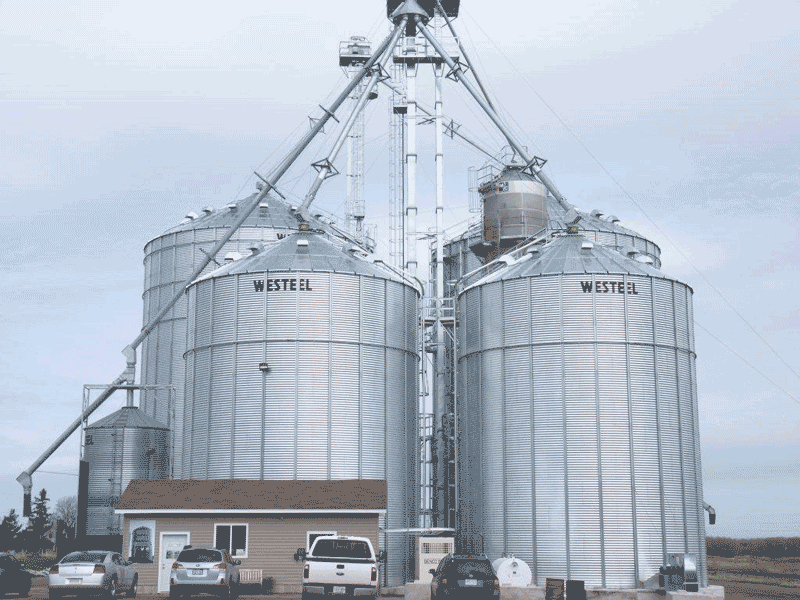Proper grain storage
A COMPONENT OF FARM SAFETY
“HOW MANY OF you have been in a bin and walked on grain?” asks Dr. Carol Jones.

She raises her hand as she looks around the chair-filled equipment shed at the farmers and other grain handlers reluctantly nodding and raising their own hands.
“We’ve all done it haven’t we? Either in the grain bin, in the combine, or in the buggy; but that’s just something we can’t do anymore.”
Jones, an engineer and associate professor of stored products engineering at Oklahoma State University, conducts research in the area of grain storage and the equipment and procedures necessary to keep grain in the best quality until it arrives at the end user. She was a featured presenter at the Grain Safety Day held at Lockie Farms Grain Elevator this summer (read more about the Grain Safety Day on page 14).
“There is such a close tie between the condition of our grain and how safe the area is to work in,” Jones says. “If everything is going well in the grain bin and the grain is in good condition, the structure is in good condition — we don’t have that many accidents because there is no reason to be in the bin fixing anything.”
moisture
As a manager of grain storage, you need to be familiar with the product you are storing and its balance with relative humidity and moisture content. Jones says every grain has its own set of laws where the relative humidity and the temperature of the grain will reach a point where no moisture goes out of the grain and no moisture goes into the grain. Corn stores a little bit wetter than soybeans and wheat has a large range for acceptable storage. The warmer the grain gets, the drier it needs to be to store safely. The cooler the temperature, the wetter the grain can be to store safely without having a lot of mould build up.
“You want to keep your grain as close to that balance as you can,” says Jones. “You do that with aeration and through drying before you put the crop in the bin.”
Moisture causes the majority of the problems inside a grain bin, including mould, stalagmites of clumped grain, and self-combustion. “If you can handle your temperature and moisture you’ve got the battle won. But it’s not as easy as it sounds,” says Jones.
One of the biggest challenges is the weather. When a cold front moves through there can be a dramatic shift in temperature during the day and if the outside air is cooler than the inside air by 20°F (10°C) condensation is going to form, unless you have enough aeration or a ventilation system that will move the condensation out.
Condensation can also be created by the moisture content of your grain. If you load grain with different moisture contents into the same bin, wherever you have a change there will be a layer of condensation that will form.
Another moisture problem can develop through over-drying and shrink, which can cause the grain to break up and create fines throughout the bin. Whenever you have fines, it can attract insects which create moisture that can lead to mould in the middle of the grain bin. Jones also cautions against overfilling a bin. You should never fill past the sidewall height because condensation will have nowhere to go but into the grain, even if you have good ventilation.
detecting problems
One of the easiest ways to determine if you have a problem is with your nose. “We all know what good grain is supposed to smell like, and if it doesn’t smell like that, you’ve got a problem,” says Jones. “You need to figure out what is causing that odour. You might even have moisture because of a leak through something as small as a bolt hole missing a bolt.”
If you do have a problem, there are several things to look at that may be the cause. Jones says they are finding more vendors are not putting enough roof vents into bins, especially as they get larger, and this reduces the amount of ventilation. “Don’t cut costs on your roof vents. Add a few extra if you need to. If you are having problems, the first place to look is do I have enough vent space.”
You also need to look at your aeration system. Have you changed crops from what that aeration system was designed for? For example, if you change from corn to canola, canola has four times the static pressure — static pressure is the pressure on the fan, or how hard it is to get the air through that product. Jones says if you have a system designed for corn or wheat it is not going to handle canola, and if you have a system designed for corn it may not even handle wheat because the static pressure of wheat is twice that of corn. Make sure you have enough aeration for the product you are storing.
You may have to monitor differently than you have before. “I’m a real firm believer in temperature cables, especially inside the larger bins. How else do you know what’s going on down in the middle of that product?” says Jones. “They are a good investment. Our economists say they will pay for themselves in two years. And you can’t manage what you don’t know is there. If you don’t know, then how are you going to fix it? You need to be able to detect problems.”
Jones says the key is to keep your grain in good condition. If you know what is in your bins, you can take the precautions to keep yourself safe. “I would like to say that you wouldn’t ever have to go into the bin, but we all know that eventually we do. So if we know there is a problem in there than we know how to keep ourselves safe.”
You can watch a video of Jones’ presentation at www.youtube.com/user/ grainfarmersontario. •

















